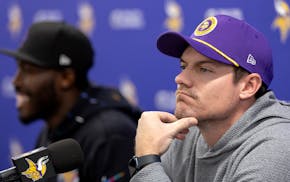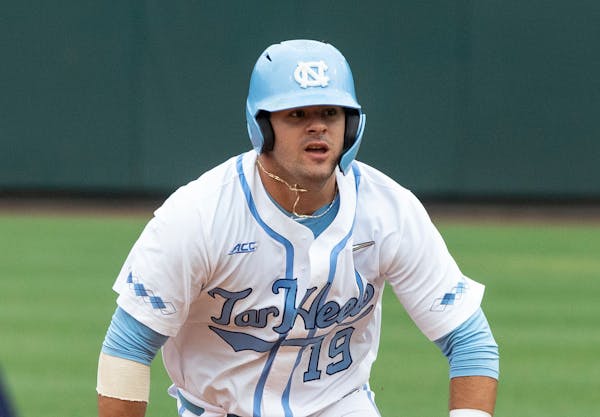The Twins signed five undrafted free agents over the past couple of weeks, a modest haul of baseball talent that likely ranks somewhere in the middle of the 30 MLB teams. Could have been better, could have been worse, Sean Johnson said.
"We got our hearts broken a couple of times, and we won a few, which is how recruiting goes," Johnson, the Twins scouting director, said of the unprecedented scramble to scoop up a share of the amateur talent left disappointed and unattached by an MLB draft that lasted only five rounds.
"We feel good about the players we signed. We believe we upgraded the talent base in our pipeline. But it's natural to think about the ones that got away."
Maybe so, but the obstacles always were going to be daunting in a process that no current scout or executive had ever experienced before. With only 160 players selected in the pandemic-stripped draft, or nearly 1,100 fewer than 2019, the talent pool of unclaimed prospects was enormous. But Major League Baseball limited bonuses to a maximum of just $20,000, and college players were granted an extra year of eligibility, meaning Johnson's staff wasn't just competing with 29 fellow suitors, but also with the tempting option of going back to school and waiting for next year's draft.
"A good chunk of the best guys, I'd say, ended up going back to school. Some were kind of on the fence, and we pursued a lot of them if they showed interest in the initial stages," Johnson said.
"It turned out to be a lot of different types of players in that pool. Some guys were still gung-ho on going pro, and wanted to sign quickly. Some guys wanted to take a few days to sign. Some guys were probably always going back to school, but wanted to see what was out there."
Without money to entice the best of them, the Twins turned to lobbying, enlisting such former players as Torii Hunter, Michael Cuddyer and LaTroy Hawkins to call prospects and sell them on the Twins organization.
"We matched it up with each player's background, who his favorite player might have been," Johnson said, pointing out that Magic Johnson made similar calls for the Dodgers. "We kind of catered to each guy, tried to individualize the process."
Especially in one case. They had their top catching prospect, Ryan Jeffers, contact lefthander Zarion Sharpe to try to persuade his former North Carolina Wilmington teammate to join him in the Twins system.
It worked.
"He was talking about how much of a family atmosphere they have, how comfortable he is not only with people in the organization but as far as player development," Sharpe said on UNCW's website. "That was one of the big things that helped me make a decision."
Teams could not contact players until 8 a.m. June 14, a Sunday, and being ready at 8:01, with scouting reports and developmental plans, was crucial, Johnson said. "This was speed-dating at its finest," he said.
The iron five
The new Twins are Sharpe, who started 33 games for the Seahawks and struck out 147 batters in 157 innings; 6-foot-6 lefthander Lucas Sweany, who struck out 92 hitters in 113 innings at the University of the Pacific; Fordham righthander John Stankiewicz, the Atlantic 10 pitcher of the year in 2019; catcher Allante Hall from Pensacola State junior college, ranked as one of the state of Missouri's top prospects out of high school; and 18-year-old shortstop Willy Diaz Vasquez, who was playing at the Prairie Baseball Academy in Lethbridge, Alberta.
Most players expressed excitement over signing their first professional contract, and it is a big moment in a young player's life. But those who signed are in some ways victims, too, of a system that MLB instituted with the players union's assent to keep expenses down in a season with little revenue.
At least a couple of the Twins' five players would likely have been chosen if the draft had included five more rounds; last year, the slot values for rounds 6-10 ranged from $301,600 at the top to $142,200 for the final pick in the 10th round. This year, none received more than $20,000.
Feast and famine
The Royals are widely believed to have had the most success in the free-agent market, signing seven players, five of them who were included on Baseball America's list of top 500 pre-draft prospects. The Phillies also netted five top-500 players among their 10 signees, and the Red Sox signed 13 players overall, more than any other team. The Angels and Rays have not announced a signing, while the Diamondbacks, Pirates and Tigers signed one player apiece.
"It was a mad dash. It was fun in some ways," said Derek Falvey, the Twins president of baseball operations. "I feel pretty good about the group we got."
Johnson agreed that it was surprisingly fun, something different for a scouting department that usually is focused on just the draft, a challenge to keep information flowing and to react to players' decisions. Can't wait for next year, right?
"I would say, I'm perfectly fine if it never happens again," Johnson said.
From your basement to U.S. Bank Stadium: How to follow the draft
NFL to open academy in Australia to identify and develop young prospects

Duran, Correa hope to return during Twins' upcoming road trip

Vikings mock draft: seven rounds, eight picks and, yes, one quarterback


